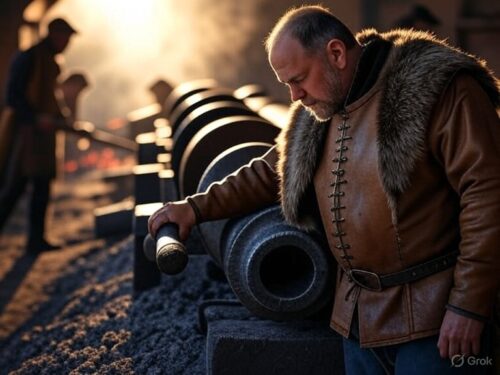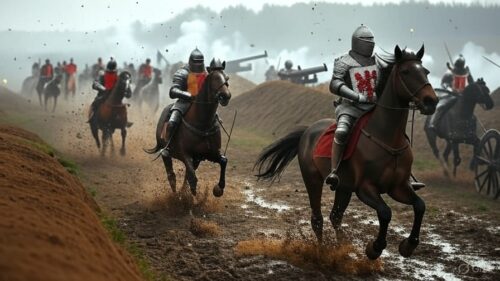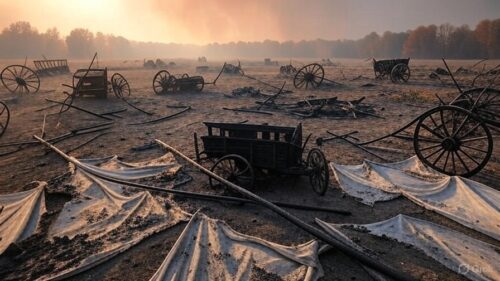Imagine standing on a gentle slope in southwestern France as dawn breaks. A haze of smoke curls over the fields. In the distance, steel wheels grind forward, hurling thunderbolts of iron at an approaching army. This was Castillon on July 17, 1453—the day gunpowder forever changed the world. Beyond swords and armor, it was artillery that won the decisive battle in the Hundred Years’ War.
Centuries later, the lessons from Castillon still resonate for anyone seeking to transform their own life. Innovation often meets resistance. Old systems cling to tradition while newcomers harness new tools to shatter the status quo. In this blog we’ll explore the deep history of Castillon’s conflict, uncover its turning points, and craft a modern action plan so you can apply the same spirit of innovation, courage, and adaptability in your own journey.
The Hundred Years’ War: A Prologue
The term “Hundred Years’ War” masks a centuries-long struggle between two great medieval powers: the Plantagenet kings of England and the Valois kings of France. Though called a single war, it consisted of intermittent campaigns, truces, and shifting alliances from 1337 to 1453—116 tumultuous years of sieges, pitched battles, and political intrigue.
At stake was sovereignty over French territory, regal legitimacy, and immense wealth. Early English successes, like Crécy (1346) and Poitiers (1356), showcased longbow mastery. Yet, over time, the French regrouped. By mid-15th century, King Charles VII of France had rallied peasant levies, knights, and nascent national institutions to reclaim lost provinces.
Castillon was the last stand of English ambition on French soil. It marks not just an endpoint but the birth of a modern world where technology and organization could overrule tradition-bound tactics.
Setting the Stage: France and England in 1453
By 1453, war-fatigue plagued both kingdoms. England’s treasury groaned under the cost of raising troops across the Channel. Internal rivalries—noble feuds, baronial grudges—sapped morale. Meanwhile, France had recovered from early disasters. Charles VII invested in infrastructure: fortifications, supply depots, and, most critically, a corps of expert gunners led by the Bureau brothers, Jean and Gaspard.
Their innovations in casting iron barrels and mounting mobile field pieces gave France an edge. Where earlier conflicts relied on archers and knights charging in tight formations, Castillon would introduce artillery as a decisive, battlefield-level weapon.
In May 1453, English commander John Talbot, Earl of Shrewsbury, gathered a force of perhaps 6,000 men to relieve the besieged town of Castillon. His reputation for bravery preceded him—Talbot had fought in Normandy and Aquitaine for decades. But he underestimated the French readiness to unleash a storm of cannon fire.
The Masterstroke: French Artillery Innovations
France’s secret weapon lay in two interlocking breakthroughs:
- Standardized Cast Iron Cannons
- Jean Bureau’s foundry near Bordeaux produced barrels with uniform bore sizes.
- Consistency meant crews could stockpile ammunition without mismatches.
- Field-Deployable Emplacements
- The Bureaus positioned their guns behind earthworks, making each gun a fortress.
- Mobile platforms allowed the French to reorient fire rapidly as English units advanced.
Thanks to these innovations, the French artillery at Castillon was not a novelty—it was a calibrated system. Each battery covered overlapping zones. Crews drilled tirelessly, achieving reload times as fast as once every two minutes.
These developments built on decades of experimentation across Christendom. Gunpowder had arrived via Constantinople in the 14th century, but most armies treated it as an expensive accessory. France, by mid-15th century, saw it as a foundational tool. The Bureau brothers secured royal funding, hired skilled metallurgists, and integrated gunners into the army’s command structure.
 The Day of Reckoning: July 17, 1453
The Day of Reckoning: July 17, 1453
At first light, Talbot’s scouts reported French activity at Castillon’s ramparts. Determined to break the siege, he launched a frontal assault. French arquebusiers and crossbowmen raked English ranks, but it was the thunder of cannon that turned the tide.
As Talbot’s men pressed uphill, they entered a lethal zone. The French unleashed grapeshot—a cluster of iron balls—into massed formations. Horses reared, knights tumbled, and pikemen staggered under the blast. The shock shattered English momentum. Talbot himself was struck down, cut off from his main body.
By midday, the English force collapsed into chaos. Survivors scattered into the fields, pursued by French cavalry. The gunpowder thunderbolt had decided the greatest medieval conflict of Western Europe.
 Aftermath and the End of a Dynasty
Aftermath and the End of a Dynasty
The scale of French victory stunned contemporaries. On July 18, France formally regained Bordeaux. By autumn, only Calais remained under English control—a tiny foothold destined to fall a century later. The Hundred Years’ War, a patchwork of campaigns and truces, reached a definitive conclusion.
Longer term:
- Feudal Bonds Gave Way to Royal Authority
- Charles VII’s fiscal reforms funded a standing army.
- Nobles who once could raise private retinues found themselves answering to the crown.
- Warfare Became Scientific
- Ballistics, metallurgy, and mathematics entered military treatises.
- Soon gunpowder would power navies, fortresses, and civilian industries.
The medieval world did not vanish overnight. Castles and knights persisted. Yet the balance had shifted irrevocably. Castillon stands as the landmark where technology and organization trumped raw valor and chivalric code.
 Why Castillon Matters Today: The Dawn of Modern Innovation
Why Castillon Matters Today: The Dawn of Modern Innovation
It’s tempting to relegate medieval battles to dusty textbooks. Yet Castillon holds timeless truths about how breakthroughs ripple across society:
- Vision Outpaces Tradition
- The French crown saw beyond knight-on-horseback wars.
- Investing in untested tech demands foresight and courage.
- Systems Over Heroes
- A single cannon was powerful, but a networked battery was decisive.
- Today’s breakthroughs often come from platform thinking—integrated, scalable, interoperable.
- Culture Shapes Adoption
- France cultivated a gunner caste, complete with training schools.
- Modern companies thrive when they build cultures that embrace experimentation and tolerate failure.
We still live in an age of disruption. From AI and biotechnology to renewable energy, each breakthrough invites skepticism. Castillon reminds us that the future belongs to those willing to question assumptions and mobilize resources behind new paradigms.
Personal Lessons from Castillon
How can you channel the spirit of July 17, 1453 into your personal or professional life? Here are targeted takeaways:
- Embrace Your “Bureau Foundry”
- Identify a resource gap in your industry or hobby.
- Treat it like a foundry: gather tools, recruit mentors, and standardize processes.
- Build Overlapping Defenses
- In a career, rely on multiple income streams or skill clusters.
- Each “battery” covers a different vulnerability—marketing know-how, financial literacy, emotional resilience.
- Drill for Reload Speed
- Practice essential tasks until they become second nature.
- Faster iteration lets you test ideas, gather feedback, and pivot.
- Rally Stakeholders Early
- The Bureaus secured royal buy-in before funding production.
- Before launching a project, gain alignment from your team, sponsor, or community.
- Prepare for the Unexpected
- Talbot expected archers at best. He never envisioned grapeshot cutting through ranks.
- Run worst-case scenario drills—financial dry runs, crisis simulations, backup plans for key partnerships.
A Four-Week Action Plan to Forge Your Own Modern “Artillery Corps”
Week 1: Intelligence Gathering
- Map your current landscape. Identify trends, emerging tools, and thought leaders in your field.
- Create a “gap analysis” document listing skills and resources you lack.
Week 2: Resource Foundry
- Acquire or subscribe to the top three tools that will upgrade your work.
- Enroll in a focused online course or workshop. Assign daily practice slots on your calendar.
Week 3: System Design
- Draft a workflow diagram illustrating how new tools integrate with existing processes.
- Pilot a small project using the new setup. Document every step and time each activity.
Week 4: Feedback and Pivot
- Host a review session with mentors or peers. Collect feedback on speed, quality, and outcomes.
- Revise your system. Remove unnecessary steps. Scale what worked by automating or delegating.
Stick to this rhythm—intelligence, resource building, systemization, review—and you’ll emulate the Bureaus’ relentless drive toward mastery.
 Conclusion
Conclusion
The Battle of Castillon might seem a relic of medieval strife. Yet its core story—of daring to invest in unproven technology, of systematizing innovation, of orchestrating teams to deliver overwhelming impact—echoes in every breakthrough from the steam engine to the smartphone.
Next time you face a challenge—launching a startup, leveling up your skills, overcoming a personal obstacle—remember July 17, 1453. Let the thunder of iron cannonballs remind you: the future belongs not to tradition, but to those bold enough to forge new paths and rally others to their cause.
Go forth. Build your “artillery.” And with eye-opening force, you’ll redefine your own battlefield.

